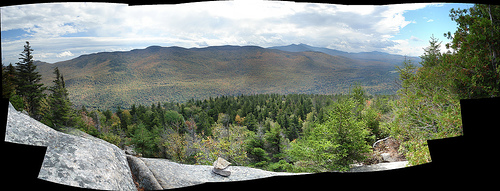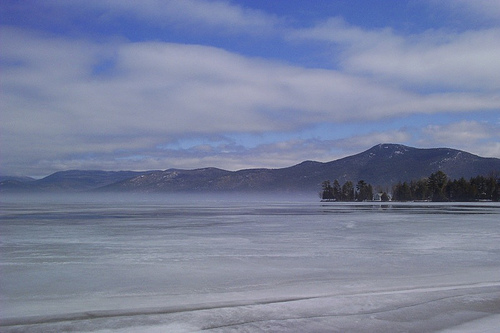The cost was $110 million – and the sellers had owned the land since the end of the Civil War.
 [Image: The "View from Noonmark Mountain" by Robbie's Photo Art, found via Flickr; this photo is simply for illustrative purposes: as far as I'm aware, it does not show the property discussed below].
[Image: The "View from Noonmark Mountain" by Robbie's Photo Art, found via Flickr; this photo is simply for illustrative purposes: as far as I'm aware, it does not show the property discussed below].These 161,000 acres, "considered the last remaining large privately owned parcels in Adirondack Park," we read, "are an ecological marvel":
- containing 144 miles of river, 70 lakes and ponds, more than 80 mountains and a vast unbroken wilderness that only loggers and a few hunters have ever seen. The property also contains unmatched natural features like the blue ledges of the Hudson River Gorge, OK Slip Falls and Boreas Pond, with its stunning views of the Adirondack high peaks, which naturalists have dreamed of protecting for decades.
So what else is out there...? And do we know?

 [Image: Two stitched panoramas of the Adirondacks: (top) Valley View Ledge" / (bottom) "View from Catamount Mountain, both by retropc, found via Flickr].
[Image: Two stitched panoramas of the Adirondacks: (top) Valley View Ledge" / (bottom) "View from Catamount Mountain, both by retropc, found via Flickr].Absurd questions, of course: it's New York state, not Borneo or even Utah – or Bosnia, for that matter – and so it seems relatively unlikely that some weird and amazing lost city or heretofore unknown species of hominid will be found out in the darkness by Nature Conservancy volunteers.
And yet I can't help but think of vague, sci fi-like scenarios of undiscovered archaeological sites – civilizations no one even dreamed existed, thriving here on the North American landmass before ice ages came and scraped the place clean – or monstrous fossils lodged in lumps of exposed bedrock, weird marks in the sides of distant hills corresponding to no known period of the earth's biological history... Crashed spaceships. The world's largest cave system. Medicinal flowers.
And so on.
Anyway, there's something about large, privately held plots of wilderness that absolutely fascinates me – and not because I advocate turning the public lands of the United States over to private interests, but because of what I might call the literary, even psychological, possibilities of owning wilderness.
In fact, I'm reminded of yet another New York Times article, this one about the large-scale private purchasing of former timber lands out west.
There is, we read, "a new wave of investors and landowners across the West who are snapping up open spaces as private playgrounds on the borders of national parks and national forests." There are thus "private ponds" – and private rivers and mountains and gullies. In fact, there are "vast national forests, grasslands and wilderness areas that in Montana alone add up to nearly 46,000 square miles, about the size of New York State" – however, "in many places, the new owners are throwing up no trespassing signs and fences, blocking what generations of residents across the West have taken for granted – open and beckoning access into the woods to fish, hunt and camp."
Then, surrounded by a few hundred acres of remote and unpopulated – and unpoliced – land, you start to do things... Gradually planning a bid for political sovereignty. Building things deep in the woods. Walking around alone at midnight, thinking about calculus, surrounded by 2000 acres of your own land.
This, in turn, reminded me of an old Clive Barker story called "Down, Satan!"
I may not have remembered the story correctly, having last read it in high school, but its premise is that a fabulously wealthy businessman decides to build Hell on Earth – literally to construct Hell – in order to summon forth the devil (or some such idea). He thus sets about designing and building a terrifying new complex full of torture machines and acid baths and vast graveyards somewhere on private land in Nevada.
At the end of the story, the police raid the place and the guy realizes that he has, in fact, summoned the devil to Earth – and it's him...
 [Image: "Serene View" in the Adirondacks, by |ash|, found via Flickr].
[Image: "Serene View" in the Adirondacks, by |ash|, found via Flickr].In any case, we learn that these sorts of transactions, involving formerly public lands, are growing much more common – but also more complex and more ambitious. "Over the last 10 years," we're told, "at least 40 million acres of private forest land have changed hands nationwide." 40 million acres! That's very nearly the size of the United Kingdom.
Of course, the motivation behind all these purchases is not preservation – or even constructing Hell: it all comes down to logging. Even environmental advocates are now picking up their chainsaws.
- In ways that would have been unthinkable only a few years ago, environmentalists and representatives of the timber industry are reaching across the table, drafting plans that would get loggers back into the national forests in exchange for agreements that would set aside certain areas for protection.
Both groups are feeling under siege: timber executives because of the decline in logging, and environmentalists because of the explosion of growth on the margins of the public lands.
(...)
Many environmentalists say they have come to realize that cutting down trees, if done responsibly, is not the worst thing that can happen to a forest, when the alternative is selling the land to people who want to build houses.
Surely someone with loads of money could finally do something interesting, for instance, putting aside the cocaine addiction and the personal fleets of Range Rovers and the Malibu mansions and buying land, buying lots of land, buying as many tens of thousands of acres as they can afford – and not developing it, not re-selling it, not clear-cutting it, not even necessarily preserving it, just doing something out there in their own private wilderness, whether it's opening a system of public trails – or maybe you can subscribe to the land the way you subscribe to a magazine, and so you get access to new trails every few months – or building radio astronomical research stations, or a summer camp for landscape journalists, or the BLDGBLOG Academy, or a human clone farm, or whatever. Build a private cave. Who cares.
But, surely, with literally tens of millions of acres of land at stake here, and with more and more – and more – people becoming billionaires, let alone millionaires, someone with a little imagination will come along finally and do something interesting out there, away from the airports, alone in the darkness of North America, surrounded by maple trees, coming up with plans, changing history, supplying novelists with fodder for plots for decades to come.
Otherwise we'll just build more houses.
No comments:
Post a Comment